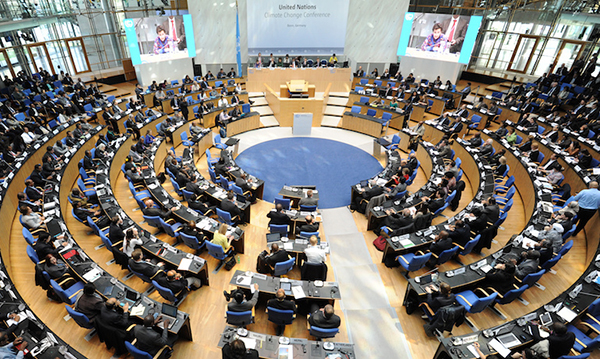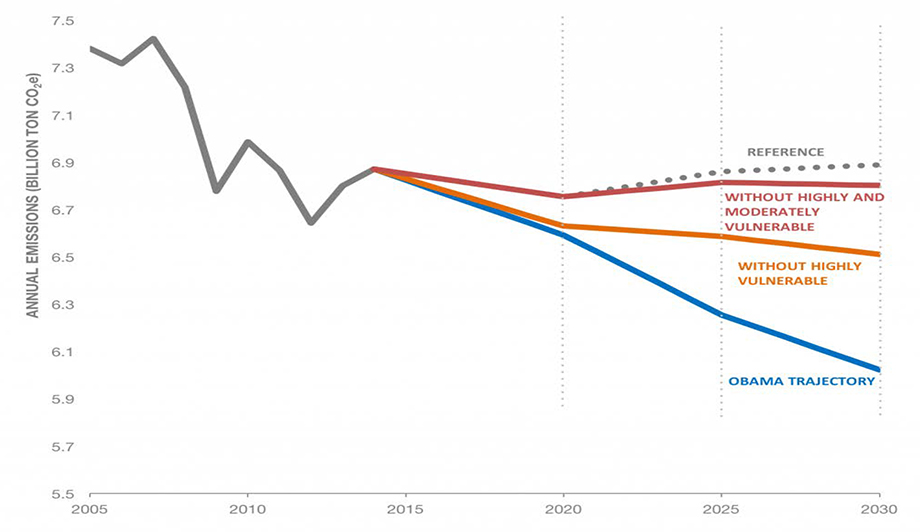Should US reveal the truth and withdraw from Paris Climate Agreement?

As the latest round of climate negotiations kick off in Bonn this week, a tug of war in the White House on climate protection may have profound impacts for future international cooperation. But it’s not about what you might think.
The debate is not between hawks calling for immediate reductions to heat-trapping emissions, and doves advocating for more gradual decarbonisation. It’s not about whether we should deploy cheap low-carbon technologies as advocated by the International Energy Agency, or invest in R&D for “energy miracles”, as favoured by Bill Gates. Nor does it concern the choice between an economy-wide carbon tax favoured by some Republicans, or the politically expedient regulations and subsidies introduced by former President Obama.
It’s not even between those who accept the overwhelming scientific consensus on climate change, and the extreme wing of fossil fuel lobby, who don’t. As climate scientists like to tell us, “the debate is over”, but not in the way they think.
The only White House climate debate is between those who see the Paris Climate Agreement as a useful branding and lobbying opportunity, and those who favour leaving the Agreement completly.
The latter includes the likes of Steve Bannon, Senior Advisor to the President, Scott Pruitt, the head of the Environmental Protection Agency, and much of the coal lobby. This group argue that the US should unilaterally withdraw from the Paris Climate Agreement.
Mr. Pruitt’s main gripe is that China and India allegedly have no obligations under the agreement until 2030. In fact, both have made commitments, which are rated on a par with the US pledge by Climate Action Tracker, an independent authority. Mr Pruitt’s comments only make sense if you ignore that the average American emits 10 times the CO2 and share 35 times the GDP per capita compared to the average Indian.
Another argument for immediate withdrawal relates to the legal nature of the US pledge to the Agreement, to lower emissions by 26 to 28 percent by 2025. Pledges can be changed by national Governments at any time. However, a caveat in the wording suggests that this could only happen to enhance the level of ambition. If the US could not weaken its commitment this could be used in court to protect the Clean Power Plan and other aspects of former President Obama’s climate legacy. The legal validity of this position is hotly contested.
The proponents of remaining include the President’s daughter and advisor, Ivanka Trump, her husband, Jared Kushner, as well as Secretary of State Rex Tillerson and national security adviser H.R. McMaster. This group are supported by the drilling lobby, including Exxon Mobil and Shell.
The Secretary of State argues that the US is better off with a seat at the table. Even a company with a long history of climate denial, Peabody Coal, wants the US to stay in so that it can promote the continued use of coal, albeit using carbon capture and storage.
Notably, there were no voices from these angels when US climate policy was dismantled over the past months. No one opposed executive orders that enabled drilling on public land, vulnerable habitats, and the Arctic, or an order to rescind the Clean Power Plan. Nor did they object when policies to build resilience and enhance national security in the face of climate change were reversed. There were no white knights in the White House when it sought (and failed) to slash the EPA’s budget, or when the White House and EPA pages on climate change disappeared. Even when coal companies were granted the right to dump waste in streams, or when climate scientists were removed from the EPA’s board in favour of lobbyist, there was silence.
Together it is estimated by Climate Advisors that rule changes already under consideration have put at stake 330 million tonnes (Mt) of CO2-eq reductions, with another 275Mt reductions vulnerable. To put the total amount in context, this is similar to the annual CO2 emissions from Brazil (503Mt), Colombia (90Mt), Costa Rica (7.6Mt), El Salvador (6Mt).
As can be seen (Fig 1), the 605 Mt estimate only accounts from reduction at stake in the period to 2030 – who knows how long it would take the US to get back on a decarbonisation pathway if all Obama-era regulations are rescinded?

Fig 1. Emissions regulations highly vulnerable and at risk
Source: Climate Advisors (2017)
Membership of the Paris Agreement is nice, but reducing US emissions is what actually matters. The current debate is really between those who want to leave Paris and totally deny climate change, and those who see Paris as a branding and lobbying opportunity.
But the Paris Agreement is not intended as a fig leaf. It is not lipstick or a branding opportunity, nor is it intended as a platform for lobbying. It is a club for countries who are part of a global effort to tackle dangerous climate change, and who are committed to emissions reductions. The US no longer meets these admission criteria.
There are legitimate arguments in favour of staying in being made by many political leaders in the US, NGOs and others. Indeed, polling suggests that the vast majority of Americans favour staying in. Should the US leave, however, the moral outrage of these constituents could be a powerful catalyst for change. There is a danger remaining could muddy the waters, and allow US citizens believe they are contributing to resolving a global problem, when the opposite is the case.
Remaining in Paris could be also be considered a useful conceit that allows other countries to maintain decarbonisation momentum. On the other hand, the EU, China and India have promised not to backslide on their commitments, and there should be sufficient international leadership to sustain the agreement. It seems unlikely in any case that countries would interpret continued US membership as true commitment to addressing climate change.
145 countries representing nearly 83% of global emissions have ratified the Agreement. It will stay in force regardless of the US position. The process of ratification is relatively straightforward, leaving a future Administration free to re-join when the domestic climate policy is more in line with membership.
Continued policy pretence leads to a place where nothing is real and nothing can be believed. Double speak of the type envisaged here can be frustrating for citizens of our democracies, and can undermine trust and belief in international institutions, and indeed in the cadre of diplomats running them. Staying in may enhance the Trump Administration brand, but it could undermine public confidence in the Agreement and ultimately the potential for international cooperation in the future.
It may be better for the US to leave now, and re-join when it is ready to behave like a responsible global citizen. My prediction is that lipstick will win out, but it would be preferable to leave and reveal the unadorned truth to the world.
Joseph Curtin is a member of the Irish Government’s Climate Change Advisory Council. He is Senior Fellow for climate policy at the Institute of International and European Affairs, Dublin, and a Research Fellow University College Cork.
